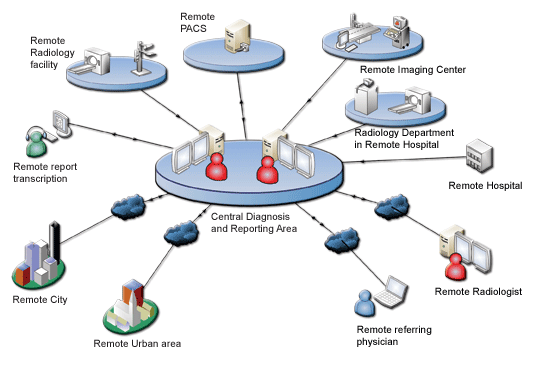|
Teleradiology is the transmission of radiological patient images, such as x-rays, CTs, and MRIs, from one location to another for the purposes of sharing studies with other radiologists and physicians. Teleradiology improves patient care by allowing Radiologists to provide services without actually having to be at the location of the patient. This is particularly important when a sub-specialist such as a MRI Radiologist, Neuroradiologist, Pediatric Radiologist, or Musculoskeletal Radiologist is needed, since these professionals are generally only located in large metropolitan areas working during day time hours. Teleradiology allows for trained specialists to be available 24/7.
Teleradiology helps radiology groups achieve greater efficiencies and deliver better care. It is dedicated to moving teleradiology forward by delivering best-in-class technologies and services. By offering superior technology and smarter workflows, to help radiology groups streamline processes, lower costs, and improve patient care is a primary aim of this technology.
Modalities supported under this are:
-
MRI Services
-
CT (Computed Tomography) Scan Services
-
Ultrasound Scan services
-
Color Doppler Services
-
X-Ray services
The Teleradioogy Wireless Netwroks Angle:
The teleradiology solution is a combination of software, hardware and connectivity facilities that facilitates remote diagnosis from anywhere in the globe. Using web enabled and web based software for image viewing and diagnosis and reporting tools few numbers of radiologists could be able to serve large number of hospitals and imaging scan centers. The solution is scalable and secured to enable the image acquisition facilities to send studies over internet or VPN to the remote diagnosis and reporting facilities, where studies can be reported and send the reports back to the hospitals to be printed locally.
The solution can have either push or pull concept with a webviewing interface, the radiologists can dowload studies directly from the hospitals then diagnos and send the report back to the hospital, Or, hospitals can send the studies acquired automatically to the remote diagnosis area to be reported.
The solution can work with multiple commnunication lineslike ADSL/SDSL lines,T1/E1 Lines, mobile 3G network and satellite channels. Depending on the type and load of studies to be transmitted, the suitable communication line is chosen.Multiple compression methods can be used to enable the best utilization of the bandwidth allocated for the solution. From Lossy JPEG transmission for clinicians to Lossless JPEG and JPEG 2000 transmission for radiologists.
Using a unified billing system, the administrator can print multiple bills of the number of reports being written, doctors operating on the system, participation percentage from anyone and detailed views on the images being stored on the main server. All the statistical reporting features are user defined so that all the users can edit and design new statistical
reports anytime. | 
